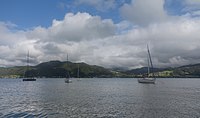Attersee (lake)
This article has multiple issues. Please help improve it or discuss these issues on the talk page. (Learn how and when to remove these template messages)
|
| Attersee Kammersee | |
|---|---|
 | |
| Location | Salzkammergut, Upper Austria |
| Coordinates | 47°54′N 13°33′E / 47.900°N 13.550°E |
| Primary inflows | Seeache |
| Primary outflows | Ager |
| Catchment area | 464 km2 (179 sq mi) |
| Basin countries | Austria |
| Max. length | 18.9 km (11.7 mi) |
| Max. width | 3.3 km (2.1 mi) |
| Surface area | 46.2 km2 (17.8 sq mi) |
| Average depth | 85 m (279 ft) |
| Max. depth | 169 m (554 ft) |
| Water volume | 3.943 km3 (3,197,000 acre⋅ft) |
| Surface elevation | 469 m (1,539 ft) |
| Islands | Litzlberg Castle |
| Settlements | Seewalchen, Schörfling, Weyregg, Steinbach, Unterach, Nußdorf, Attersee |
Attersee, also known as Kammersee, English sometimes Lake Atter,[1][2] is the largest lake of the Salzkammergut region in the Austrian state of Upper Austria. It is Austria's third largest lake by area, surpassed only by Lake Constance and Lake Neusiedl, which, however, both of those larger lakes extend beyond national borders.
Geography[edit]
The surface area of Lake Attersee extends for about 20 km (12 mi) from north to south and 4 km (2.5 mi) from east to west. With an average depth of 85 m (279 ft), its water volume even surpasses the Chiemsee, which is larger by area.
The main inflow is the Seeache creek, which flows out of the nearby Mondsee lake in the southwest. Both Attersee and Mondsee are part of a chain of lakes, beginning with Fuschlsee and Irrsee. The waters flow off with the Ager River down to the Traun which itself discharges into the Danube at Linz.
In the southwest of the lake the Schafberg ("Sheep Mountain"), part of the Salzkammergut Mountains, rises up to 1,782 m (5,846 ft), separating it from the Mondsee lake, whose southern shore borders the state of Salzburg. The Höllengebirge (literally "hell mountains") karst range, with a height of up to 1,862 m (6,109 ft), is located southeast of the lake.
Due to its steady winds and clean water quality, Attersee is famous for attracting sailors and swimmers alike. During the season numerous sailing competitions are held. One of the most cherished winds on Attersee is the so-called "Rosenwind" meaning "breeze of roses". It is an easterly wind that crosses a castle's rose garden and fills the air across the lake with the smell of roses. The surrounding settlements largely depend on tourism, mainly in spring, summer and autumn.
Because of the lake's size and despite the cold temperatures during winter the lake rarely freezes. The last time the lake was entirely covered with ice was in the late 1940s, when people were seen skating and riding motorcycles across the thickly frozen surface of the lake.
History[edit]

The name Atter, derived from ata meaning "water", probably is of proto-Celtic origin. The shores were already settled in the Neolithic era. In August 1870, remains of prehistoric pile dwellings were found near Seewalchen at the northern end of the lake. The Mondsee group stilt houses since 2011 are part of the UNESCO Prehistoric pile dwellings around the Alps World Heritage Site. Other archaeological findings denote settlement activities in Roman times from the 2nd century BC onwards.
In the middle of the 19th century paddlesteamers were introduced on the lake to ferry mail and goods between the villages located around the Attersee. Today it is an important recreation site for people from the urban areas of Vienna and Linz.
From the Fin de siècle, Attersee became a popular destination for summer guests, apart from the bustle at the emperor's sojourn in nearby Bad Ischl. Near the village of Litzlberg, part of Seewalchen, there is a small island castle, which Gustav Klimt frequently visited during the summer. Likewise, the German painter Albert Weisgerber was a summer visitor on Attersee.
Lake Attersee was a rallying point for several German divisions during World War II which had retreated during the Siege of Budapest. Among these were several foreign volunteer divisions of the Waffen-SS, which sought to reach Attersee where surrender to the Americans was preferable to capture by the Red Army.
The lake is celebrated in the Viennese painter Gustav Klimt's work Insel im Attersee.[3]
Fishing[edit]
Among the fish species found in the lake are:
- Northern pike
- Brown trout
- Rainbow trout
- Arctic char (Salvelinus alpinus)
- Lake char (Salvelinus umbla)[4]
- European eel
- Carp
- Burbot
- Perch
- Whitefish
Panorama[edit]
Gallery[edit]
-
View to the lake from Attersee am Attersee
-
View to Weyregg am Attersee from Attersee am Attersee
-
View to the lake from between Weyregg am Attersee and Steinwand
-
View to the lake from between Steinbach and Weissenbach
References[edit]
- ^ S. Jost Casper, ed. (1985). "Lake Stechlin: A Temperate Oligotrophic Lake". Monographiae Biologicae. 58. doi:10.1007/978-94-009-5506-6. ISBN 978-94-010-8930-2. S2CID 40861760.
- ^ Francesco Menotti, ed. (2007-08-23). "Living on the Lake in Prehistoric Europe: 150 Years of Lake‐Dwelling Research". International Journal of Nautical Archaeology. 36 (2): 432–433. doi:10.1111/j.1095-9270.2007.163_4.x.
- ^ https://www.sothebys.com/en/buy/auction/2023/modern-evening-auction/insel-im-attersee-island-in-the-attersee
- ^ "Ichthyology 7150: Salvelinus umbla". MCZBASE: The Database of the Zoological Collections. Museum of Comparative Zoology.






